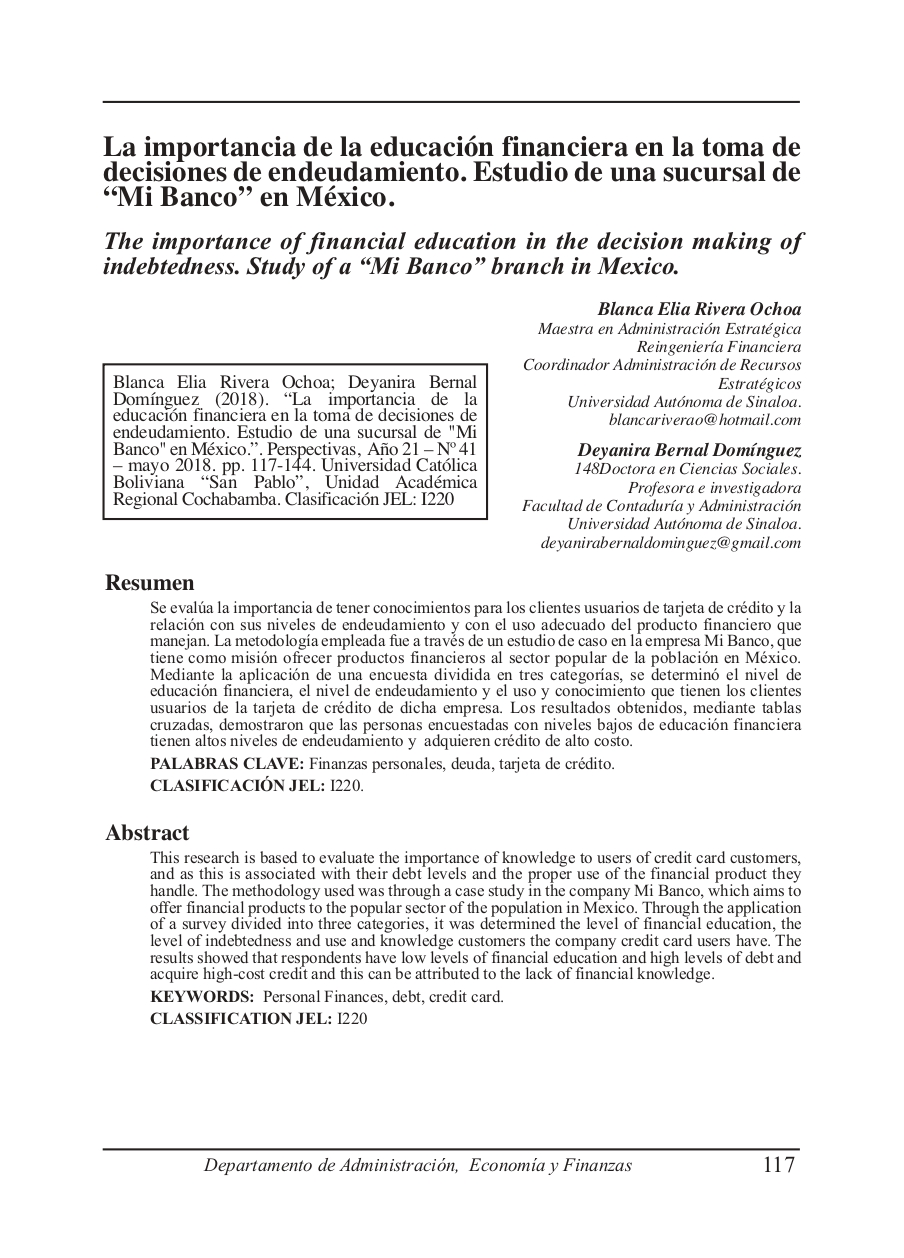The importance of financial education in the decision making of indebtedness. Study of a “Mi Banco” branch in Mexico.
DOI:
https://doi.org/10.35319/m4wq7p07Keywords:
Personal finances, Dedt, Credit cardAbstract
This research is based to evaluate the importance of knowledge to users of credit card customers, and as this is associated with their debt levels and the proper use of the financial product they handle. The methodology used was through a case study in the company Mi Banco, which aims to offer financial products to the popular sector of the population in Mexico. Through the application of a survey divided into three categories, it was determined the level of financial education, the level of indebtedness and use and knowledge customers the company credit card users have. The results showed that respondents have low levels of financial education and high levels of debt and acquire high-cost credit and this can be attributed to the lack of financial knowledge.
Downloads
References
Asociación de Bancos de México (ABM). (2008). Banco de México. México. Recuperado de https://www.banxico.org.mx/publicaciones-y-discursos/publicaciones/seminarios/modernizacion-e-inclusion-financiera-en-america-la/%7BD7A93048-E8D6-B567-FC12-13E8A568B29E%7D.pdf
Atkinson, A., & Messy, F. (2012). Measuring financial literacy: Results of the OECD / International Network on Financial Education (INFE) pilot study (OECD Working Papers on Finance, Insurance and Private Pensions, No. 15). OECD Publishing. https://doi.org/10.1787/5k9csfs90fr4-en
Banco Nacional de México (BANAMEX) & Universidad Nacional Autónoma de México (UNAM). (2008). Primera encuesta sobre cultura financiera en México. Recuperado de https://es.slideshare.net/SaberCuenta/encuesta-corta-final
Banco Nacional de México (BANAMEX). (2014). Cultura financiera de los jóvenes en México.
Banco de Ahorro Nacional y Servicios Financieros (BANSEFI). (2016). Bansefi y la educación financiera.
Banco de México (BANXICO). (2016). Instituciones financieras.
Banco de México (BANXICO). (2017). Banxico educa.
Bernheim, B. D., Garrett, D. M., & Maki, D. M. (2001). Education and saving: The long-term effects of high school financial curriculum mandates. Journal of Public Economics, 80(3), 435–465. https://doi.org/10.1016/S0047-2727(00)00120-1
Comisión Nacional Bancaria y de Valores (CNBV). (2012). Encuesta Nacional de Inclusión Financiera. Recuperado de http://www.cnbv.gob.mx/Inclusi%C3%B3n/Documents/Encuesta%20Nacional%20de%20Inclusi%C3%B3n%20Financiera%202012.pdf
Comisión Nacional Bancaria y de Valores (CNBV). (2016). Reporte de inclusión financiera 7. México: CNBV. Recuperado de http://www.cnbv.gob.mx/Inclusi%C3%B3n/Documents/Reportes%20de%20IF/Reporte%20de%20Inclusion%20Financiera%207.pdf
Coates, K. (2009). Educación financiera: temas y desafíos para América Latina. Conferencia Internacional OCDE–Brasil.
Cortez, A., & Muller, F. (2007). Equilibrio económico. Equilibrio Económico.
Disney, R., & Gathergood, J. (2011). Financial literacy and indebtedness: New evidence for UK consumers. The University of Nottingham. Recuperado de https://www.nottingham.ac.uk/cfcm/documents/papers/11-05.pdf
Disney, R., & Gathergood, J. (2012). Financial literacy and consumer credit portfolios. Journal of Banking & Finance. Recuperado de https://www.sciencedirect.com/science/article/pii/S0378426613000381
Figueroa Delgado, L. (2013). Las finanzas personales. Revista EAN, (65), 123–144. https://doi.org/10.21158/01208160.n65.2009.463
Garay, G. (2015). Las finanzas conductuales, el alfabetismo financiero y su impacto en la toma de decisiones financieras, el bienestar económico y la felicidad. Perspectivas, (36).
García, E. L. A., Grant, M. G. A., & Mejía, F. E. (2015). Contexto de la educación financiera en México. Ciencia Administrativa, (1), 21–30.
Gathergood, J. (2012). Self-control, financial literacy and consumer over-indebtedness. Journal of Economic Psychology, 33(3), 590–602. Recuperado de https://www.sciencedirect.com/science/article/pii/S0167487011001735
Herrera Guzmán, E., & Raccanello, K. (2014). Educación e inclusión financiera. Revista Latinoamericana de Estudios Educativos, 44, 119–141. Recuperado de http://www.redalyc.org/articulo.oa?id=27031268005
Hilgert, M. A., Hogarth, J. M., & Beverly, S. G. (2003). Household financial management: The connection between knowledge and behavior. Federal Reserve Bulletin, 89, 309. Recuperado de http://heinonline.org/HOL/LandingPage?handle=hein.journals/fedred89&div=90&id=&page=
Klapper, L. F., Lusardi, A., & Van Oudheusden, P. (2015). Financial literacy around the world: Insights from the Standard & Poor’s Ratings Services Global Financial Literacy Survey. Recuperado de https://www.spglobal.com/corporate-responsibility/global-financial-literacy-survey
Lusardi, A. (2008). Financial literacy: An essential tool for informed consumer choice? (NBER Working Paper No. w14084). National Bureau of Economic Research.
Lusardi, A., & Tufano, P. (2009). Teach workers about the perils of debt. Harvard Business Review, 87(11), 22–24. Recuperado de https://hbr.org/2009/11/teach-workers-about-the-perils-of-debt
Lusardi, A., & Mitchell, O. S. (2011). The outlook for financial literacy (NBER Working Paper No. w17077). National Bureau of Economic Research. Recuperado de http://www.nber.org/papers/w17077
Lusardi, A. (2012). Numeracy, financial literacy, and financial decision-making (NBER Working Paper No. w17821). National Bureau of Economic Research. Recuperado de http://www.nber.org/papers/w17821.pdf
Lusardi, A., & de Bassa Scheresberg, C. D. (2013). Financial literacy and high-cost borrowing in the United States (NBER Working Paper No. w18969). National Bureau of Economic Research. Recuperado de http://www.nber.org/papers/w18969
Marshall, E. (2014). El desafío de la educación financiera. Banco Central de Chile, 2–8.
Murray, R. S., & Spiegel, L. J. (2009). Estadística (4ª ed.).
Organización para la Cooperación y el Desarrollo Económicos (OCDE). (2005). Improving financial literacy: Analysis of issues and policies. OCDE Publishing.
Red Financiera. (2008). Libro maestro de educación financiera.
Ruíz, E. (2011). Educación financiera en México. Ford Foundation International Fellowships Program. Recuperado de http://ford.ciesas.edu.mx/downloads/2do_1_04.pdf
Stango, V., & Zinman, J. (2009). Exponential growth bias and household finance. The Journal of Finance, 64(6), 2807–2849.
Sebastián, A., & López, J. (2001). Gestión bancaria. España: McGraw-Hill.
Van Rooij, M., Lusardi, A., & Alessie, R. (2011). Financial literacy and stock market participation. Journal of Financial Economics, 101(2), 449–472. Recuperado de https://www.sciencedirect.com/science/article/pii/S0304405X11000717
Zaldívar, M. (2012). Impacto de la educación financiera en las decisiones de inversión en el sistema bursátil [Tesis de Maestría, Instituto Politécnico Nacional, México].

Downloads
Published
Issue
Section
License
Copyright (c) 2018 Revista Perspectivas

This work is licensed under a Creative Commons Attribution-NonCommercial-ShareAlike 4.0 International License.
La Revista Perspectivas de la Universidad Católica Boliviana, es una revista de acceso abierto, por lo tanto, es de libre acceso en su integridad. Está permitida su lectura, búsqueda, descarga, distribución y reutilización legal en cualquier tipo de soporte únicamente para fines no comerciales, siempre y cuando la obra sea debidamente citada.




